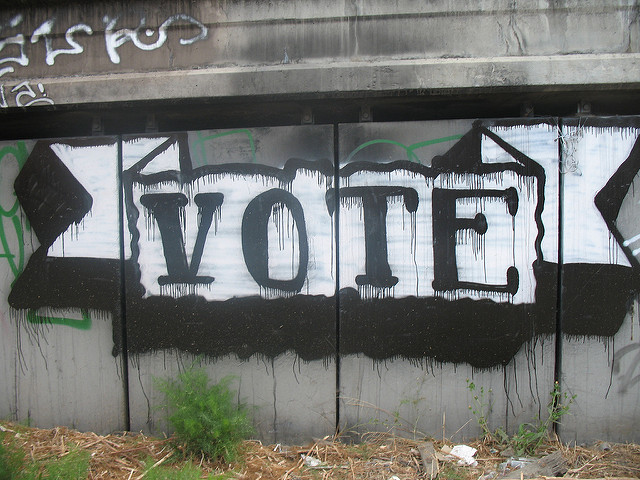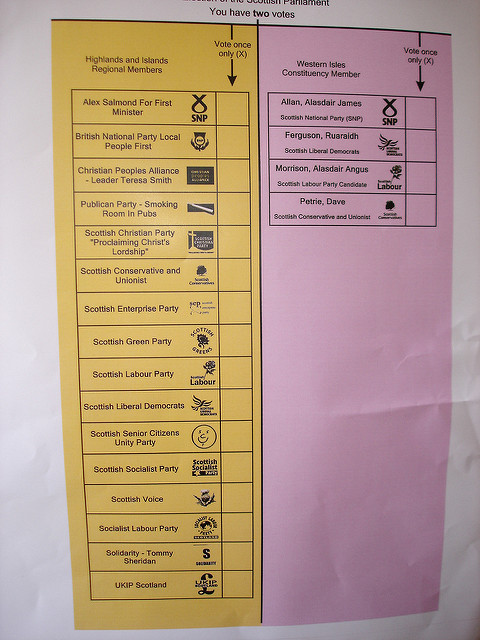In Scotland, Wales and the London Assembly elections every voter has TWO choices tomorrow. Here’s how to use both votes well
Voters are used to a two-vote electoral system for the Edinburgh Parliament, and the Assemblies in Cardiff and London. But how these systems operate changes a bit every time, with changing party fortunes. And this year some politicians (especially in Scotland) are advising voters to do things that may ‘waste’ one of their votes. Wherever you stand politically, Professor Patrick Dunleavy explains how to use both your votes so as to achieve more of what you want.

Credit: H2Woah! CC BY-NC-ND 2.0
The voting system used since 1999 for the Scottish Parliament, the Welsh National Assembly and the Greater London Assembly gives electors two votes each. Voters choose who to represent them in a local constituency close by, and who to back for ‘top-up’ seats at a wider region level. This way of voting is called the Additional Member System (or AMS). It helps give citizens more choice over who they support. And it works to produce the best possible fit between how voters cast their ballots and how seats are allocated to parties – i.e. it boost proportionality.
In this post, I first briefly describe how the AMS system works, then make some suggestions on how to get the maximum effect politically – whatever it is that you want to accomplish. After that I consider some special factors that apply in Scotland, Wales and London, which voters in each contest might want to think about as well.
How the Additional Member voting system works
In this system over half the members of the Scottish Parliament (MSPs), the Welsh Assembly (AMs) and Greater London Assembly are elected in local constituencies, using the age-old voting system familiar from Westminster elections. The remaining 40 to 45 per cent of representatives for each body (the ‘additional members’) are elected in larger regional areas using a proportional representation system. These seats are allocated across parties so as to match every party’s share of total seats won to their votes share.
Voters get two ballot papers, one for their local constituency and one for the wider regional contest, and simply mark one X vote on each paper. In each of the local constituencies whoever gets the largest vote is the winner.
But in AMS voters also have a second vote for their regional or top-up members. Candidates are put forward on regional lists by each party. To decide who should get these additional members we look at how many local seats a party already has within a region from the local contests, and at what share of the second or list votes it has in this region. If a party already has its full share of seats, it gets none of the top-up members. But if the party does not have enough seats already, then we assign it additional members, taken from its regional list of candidates. This should bring each party up to having equal shares of seats and vote. There’s a formula for doing this that works near perfectly, but may slightly over-represent larger parties if a lot of the list vote is split across multiple smaller parties.
In the AMS system you can never harm your top preference party or candidate by using both your votes. So everyone should make sure they fill in both ballot papers. But, as ever in political life, there are some politicians giving voters very bad, self-serving advice. They are suggesting ways to behave in the polling booth that could lead to voters having less of a say than they can or should.
How should you decide how best to vote with AMS elections? As a general rule, consider these points:
- If you want to support both a big party and a smaller party then bear in mind that voting for smaller parties at the local constituencies’ level will rarely help them much, because they normally cannot win there. In contrast, backing a smaller party at the regional or top-up level is generally more effective in helping them win seats.
- To see who are the top contenders in the local seats contest in your area, just enter your postcode into com. The key numbers to look at are the results last time, and perhaps in previous years. However, bear in mind that in Scotland the position of the parties has changed a lot since 2011, because of the 2014 Independence Referendum. And in London and Wales the Liberal Democrats are still well down on their earlier support levels.
- Some parties and politicians may advise that you give both your local constituency and your regional top-up votes to them, but if you do so there may be a danger that you will ‘waste’ your second vote. I explain why this will be the case in much of Scotland, and some parts of Wales below.
- In London some small parties may also not be able to win any seats, for reasons I explain below.
Using both your votes in Scotland
The Scottish AMS system normally operates very well, but the unusually strong ascendency of the Scottish National Party at present creates some possible difficulties for voters. Many SNP politicians and activists are currently urging voters to give both their local and regional votes to the SNP. And of course that is a perfectly valid choice if you are strongly committed to this party.
But bear in mind that at the 2015 general election the SNP won 56 out of 59 local Westminster constituencies, and this year they again face a very fragmented opposition. So the SNP are almost certain to sweep the board in most of the Scottish Parliament local seats using at the first past the post voting stage. If they do so, then voting SNP also in the regional list part of the election would effectively be to waste your second vote. The SNP could be so drastically over-represented already in terms of the more numerous local seats that they cannot possibly win any more seats at top-up stage.
So if you are an SNP supporter across most of Scotland, there is just no risk at all to the SNP’s chances of winning seats in looking at the other parties and possibly giving your regional preference to one of them. You can (in effect) get two bites at the cherry and maximise the representation of parties closest to your views. To check out who’s likely to do well in your area, just go to democraticdashboard.com and put in your postcode. Bear in mind that the Westminster 2015 result may now be the best guide to who will win locally, rather than the older 2011 results from the last Scottish Parliament elections.
If you are not an SNP supporter, then the regional vote will be the most important one for how your party wins seats right across Scotland – whatever else you do, make sure you give that vote to your favourite party. If you were planning to vote tactically to try to limit the SNP’s likely seats gains at the local seats level, then again put your postcode into democraticdashboard.com and check out the situation in your area. You might find that backing another party that you quite like offers the best chance of influencing your local results.
Using both your votes in Wales
The Welsh National Assembly elections can sometimes operate more disproportionately if the Labour party is doing well. This is because the party wins a lot of local seats using first past the post voting, and in the Wales Assembly there are actually far too few regional top-up seats to fully offset Labour’s over-representation.
Is Labour likely to be over-represented this time in 2016? Anthony Wells from the invaluable UK Polling Report has recently commented:
‘There is comparatively little polling in Wales and the only regular and recent figures are the YouGov polls for ITV Wales and Cardiff University (ably reported on by Roger Scully at his Elections in Wales blog). The most recent figures there are CON 19%, LAB 33%, LDEM 8%, Plaid 21%, UKIP 15% for the constituency and
CON 19%, LAB 29%, LDEM 8%, Plaid 22%, UKIP 15% in the regional vote. There will be a final YouGov Wales poll on ITV news tomorrow night’.
Labour look certain to get a lot of the local seats again, especially in south Wales, but they are not in a dominant position like the SNP in Scotland. If you support them and live in a Labour stronghold in south Wales you might want to check on democraticdashboard.com and see if giving the party your regional vote might be a waste of time, because they will already be over-represented in the top-up region. If so, then you could safely give your regional vote to another party, without damaging Labour’s seats total.
Voting in London
In the capital there are 14 local seats made up of two or three boroughs lumped together. Almost all of them are likely to be Conservative versus Labour contests this year. If you put your postcode into democraticdashboard.com you can find out what the situation was in your local area last time around.
The top-up region for London is the city as a whole. With 11 seats to distribute here, the parties rather smaller than the big two (the Liberal Democrats, Greens and UKIP) all stand quite a good chance of being fairly represented there. If you want to back one of these parties it is key to give them your second, London-wide list vote.
The only risk of ‘wasting’ a vote in London comes from backing much smaller, micro-parties. In order to win any seats at all in the GLA, then by law a party must get at least 5 per cent of list votes across London as a whole. So backing a ‘micro-party’ for the London-wide vote may not be an effective choice, although of course it is a perfectly valid one. I show below who won how many votes at this stage last time. Only the parties marked in yellow are likely to be in with a chance of winning seats in this year’s GLA election.
Who won votes and seats at the London-wide stage of the 2012 GLA election?
Use both your votes to get what you want!
This Thursday, whatever combination of parties, or single party, that you support, using both your votes can help maximise your influence over the outcomes.
—
 To find out more about the 2016 elections in your area, visit the Democratic Dashboard.
To find out more about the 2016 elections in your area, visit the Democratic Dashboard.
Note: this post represents the views of the author and not those of the LSE. Please read our comments policy before posting.
—
 Patrick Dunleavy is Director of the Democratic Audit of the UK, a non-partisan think tank encouraging improved democratic practices across the UK.
Patrick Dunleavy is Director of the Democratic Audit of the UK, a non-partisan think tank encouraging improved democratic practices across the UK.







 Democratic Audit's core funding is provided by the Joseph Rowntree Charitable Trust. Additional funding is provided by the London School of Economics.
Democratic Audit's core funding is provided by the Joseph Rowntree Charitable Trust. Additional funding is provided by the London School of Economics.
… [Trackback]
[…] Read More: democraticaudit.com/?p=21605 […]
Every voter in Scotland, Wales & London Assembly elections has TWO choices today. Here’s how to use both votes well: https://t.co/o6WaHz3aHy
Your list vote is crucial, maximise the representation of parties closest to your views.
https://t.co/g01Bh6meUd https://t.co/yYG0YslV2B
How voters in #Scotland, #Wales and #London can use both votes to maximise their influence, by @PJDunleavy https://t.co/brRXfiRDy3
Scotland Wales & LDN check out advice from @PJDunleavy & info via @DemocraticDash to maximise your 2 votes tomorrow https://t.co/plSOGF15Tz
In Scotland, Wales and the London Assembly elections every voter has TWO choices tomorrow.… https://t.co/8QPojwBJMY https://t.co/cbZEiLxRpY